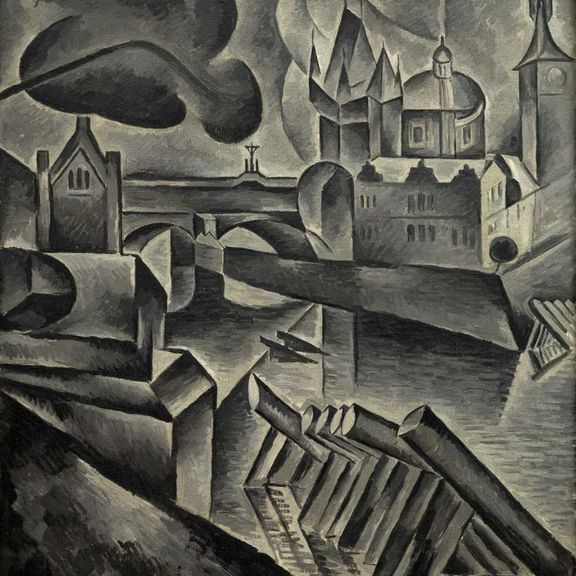
oil on canvas
1909
lower centre
65 × 80 cm
frame
The presented painting, Still Life with Lemons, comes from the period of the Prague intermezzo between Kubišta’s two stays in Paris in 1909 and 1909–1910. At the end of August, Kubišta returned from Paris to Prague in order to convince his friends and fellow artists, V. Beneš and E. Filla, to help him organise an exhibition of French art in Prague. He was particularly interested in those French artists, who were exhibiting under direction of H. Matisse at the Salon of Independents. After a while, he got enough support for his idea and everything was set in motion, however, the Paris-based painter Strimpl and later A. Matějček were entrusted with the organisation. Kubišta was disappointed, mainly because he had visited exhibitions of many important artists in Paris and was therefore convinced of which artists should definitely not be absent from the Prague exhibition. Among them was likely Paul Cézanne, who unfortunately was not represented in the end. Kubišta visited his exhibition in Paris and was enchanted with his unique system of modelling the composition by colour. Kubišta’s series of still lives from 1909, (Still Life with Peonies, Still Life, Still Life with a Blue Jug, and Still Life with Lemons), which he probably executed immediately after returning from his first visit to Paris, drew inspiration from this. We have several documents for Kubišta’s fascination with Cézanne. First, his letter to his uncle from 1909, where he directly mentioned the Cézanne exhibition, and then the extensive study he wrote on Cézanne during his second stay in Paris in 1910. In contrast to Cézanne’s airiness, Kubišta built an analytical and precisely defined compact volume in his paintings, and also used a heightened colour palette which was very likely based on Utitz’s theory of the effectiveness of the contrast of complementary colours.It is precisely the ultimate colour contrast that creates a special kind of expression in the painting, which can be attributed to Kubišta as his independent invention. The centre of this contrasting relationship in the painting can be seen in the composition of bright yellow and dark purple. We can also see several other differences from Cézanne in the composition. Kubišta decided to open the still life into the space, which he further supported with the perspective of the table. For his approach to composition, Kubišta had an ideological inspiration as well, namely Karl Wyneken and his work Der Aufbau der Form. Kubišta was deeply convinced that the creation of a modern painting has a spiritual essence and that by learning the laws and rules of creation, and understanding them, he could “bring painting to a creative height”, as A. Matějček wrote in the anthology “Life and Personality of Boh. Kubišta in the Memories of his Contemporaries”. This painting is therefore an example and evidence of this artist’s intensive search and research, and at the same time one of the top works of his (inter)Parisian period.The presented painting has been often reproduced in Bohumil Kubišta’s monographs, in the catalogues of his solo exhibitions, and in many professional studies. The most important are the following: František Kubišta: Bohumil Kubišta, Brno 1940, fig. 20; František Kubišta: Bohumil Kubišta, Prameny, 1941, fig. 15; Pestrý týden 19, 2/9/1944; Výtvarná práce 5, 1957, p. 5, catalogue of the comprehensive exhibition of Bohumil Kubišta, Mánes, Prague, September–October 1960, p. 12 and 13; Bohumil Kubišta, Correspondence and Reflections (ed. František Čeřovský and František Kubišta), Prague, 1960, fig. 23; Miroslav Lamač: Attempts at Synthesis in the work of Bohumil Kubišta, Umění 10, 1962, p. 43; Miroslav Lamač: Moderne tschechische Malerei, Artia, Prague, 1967, fig. 18, p. 40; Mahulena Nešlehová: Bohumil Kubišta, Odeon, Prague 1984, fig. 50, p. 62, cat. No. 112; Miroslav Lamač: Osma and Group of Visual Artists [Skupina výtvarných umělců], Odeon, Prague, 1988, fig. 130, p. 136; Karel Srp: Radiant Crystal, Gallery of Fine Arts in Ostrava, 2014, p. 140, fig. 97. Assessed during consultations by doc. PhDr. M. Rakušanová, Ph.D., and PhDr. J. Machalický. The expertise by PhDr. K. Srp is attached. Solo exhibitions:Prague 1920 – Posthumous Exhibition of Bohumil Kubišta, Krasoumná jednota [Kunstverein für Böhmen], Rudolfinum, Prague 1920 (cat. No. 13)Hradec Králové – Posthumous Exhibition of Bohumil Kubišta, Municipal Industrial Museum, 1–26 May 1920 (cat. No. 4)Brno 1922 – Bohumil Kubišta, Museum of Applied Arts, 22 January – 27 February 1922 (cat. No. 13)Brno 1940 – Collection of Paintings and Drawings by Bohumil Kubišta, The Aleš Hall, 8–29 September 1940 (cat. No. 12)Prague 1960 – Work of Bohumil Kubišta, Mánes, 18 September – October 1960 (cat. no. 57)Hradec Králové 1964 – Bohumil Kubišta 1884–1918, Regional Gallery, 11 October – 8 November 1964 (cat. No. 18)Karlovy Vary 1969 – Bohumil Kubišta. Selection of Works, Gallery of Art, 15 June 2019 – 27 July 1969 (cat. No. 12)Louny 1984 – Bohumil Kubišta, Luna Exhibition Hall, 6 October – 4 November 1984 (cat. No. 11)Litoměřice 1992 – Bohumil Kubišta 1884–1918, North Bohemian Gallery of Fine Arts, 19 November 1993 – 17 January 1993 (cat. no. 16)Prague 1993 – Bohumil Kubišta 1884–1918, National Gallery, Waldstein Riding School, 25 February – 30 May 1993 (cat. No. 35)Collective exhibitions:Brno 1957 / Prague 1958 – Founders of Czech Modern Art, Brno House of Arts and Prague Castle Riding School, 2 March – 31 March 1958 (not published in the catalogue)Prague 2007 – Remembering Otakar Štorch-Marien’s Aventine Mansard, Zdeněk Sklenář Gallery, 6–30 November 2007 (without catalogue)







